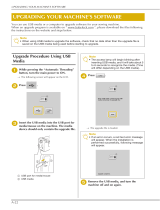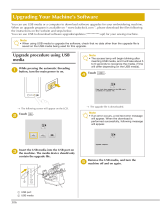Page is loading ...

2
nN
Contents
Before Use.......................................................................... 4
Finding More about Your VAIO Computer .................... 5
Ergonomic Considerations ............................................ 7
Getting Started.................................................................... 9
Locating Controls and Ports........................................ 10
About the Indicator Lights ........................................... 14
Setting Up Your Computer .......................................... 15
Shutting Down Your Computer Safely ........................ 23
Using the Power Saving Mode.................................... 24
Updating Your Computer ............................................ 26
Using Your VAIO Computer.............................................. 27
Using the Keyboard..................................................... 28
Using the Mouse ......................................................... 34
Using the Touch Screen.............................................. 40
Using the Built-in Camera ........................................... 44
Using the Optical Disc Drive ....................................... 45
Using the TV Function................................................. 53
Using the Remote Commander................................... 55
Using "Memory Stick".................................................. 59
Using Other Modules / Memory Cards ........................ 65
Using the Internet........................................................ 69
Using the Network (LAN) ............................................ 70
Using the Wireless LAN...............................................71
Using the Bluetooth Function ......................................78
Using Peripheral Devices..................................................83
Connecting External Speakers or Headphones ..........84
Connecting an External Microphone ...........................85
Connecting a USB Device ...........................................86
Connecting an i.LINK Device.......................................88
Customizing Your VAIO Computer....................................90
Setting the Password...................................................91
Using the VAIO Control Center ...................................96
Upgrading Your VAIO Computer.......................................97
Adding and Removing Memory ...................................98
Precautions .....................................................................104
Safety Information .....................................................105
Care and Maintenance Information ...........................107
Handling Your Computer ...........................................108
Handling the LCD Screen/Touch Screen ..................110
Using the Power Source............................................111
Handling the Built-in Camera.....................................112
Handling Discs...........................................................113
Handling "Memory Stick" ...........................................114
Handling the Built-in Storage Device .........................115

3
nN
Troubleshooting .............................................................. 116
Computer .................................................................. 118
System Security ........................................................ 124
Built-in Camera ......................................................... 125
Networking ................................................................ 127
Bluetooth Technology ............................................... 130
Optical Discs ............................................................. 134
Display ...................................................................... 138
Printing ...................................................................... 140
Microphone ............................................................... 141
Mouse ....................................................................... 142
Speakers ................................................................... 144
Touch Screen............................................................ 145
Keyboard................................................................... 146
Floppy Disks.............................................................. 147
Audio/Video............................................................... 148
"Memory Stick".......................................................... 151
Peripherals ................................................................ 152
Trademarks..................................................................... 153
Notice.............................................................................. 155

4
nN
Before Use >
Before Use
Congratulations on your purchase of this Sony VAIO
®
computer, and welcome to the on-screen User Guide. Sony has
combined leading-edge technology in audio, video, computing, and communications to provide a state-of-the-art personal
computing experience.
!
External views illustrated in this manual may look slightly different from those of your computer.
How to find specifications
Some features, options, and supplied items may not be available on your computer.
To find out about the configuration of your computer, see the Specifications (supplied with your computer).

5
nN
Before Use >
Finding More about Your VAIO Computer
Finding More about Your VAIO Computer
This section provides support information about your VAIO computer.
1. Printed Documentation
❑ Quick Start Guide — An overview of components connection, set-up information, etc.
❑ Specifications — The hardware configurations of your VAIO computer.
❑ Recovery and Troubleshooting Guide
❑ Safety Regulations
2. On-screen Documentation
❑ VAIO Manual — General information and technical assistance for your VAIO computer.
To access VAIO Manual, double-click VAIO Manual on the desktop.
❑ Windows Help and Support — A comprehensive resource for practical advice, tutorials, and demonstrations to help you
learn to use your computer.
To access Windows Help and Support, click Start and Help and Support, or press and hold the Microsoft Windows
key and press the F1 key.

6
nN
Before Use >
Finding More about Your VAIO Computer
3. Support Web Sites
If you have any problem with the computer, you can visit the following VAIO online web sites for troubleshooting:
❑ http://www.sony-asia.com/support/vaio/
(English)
❑ http://scs.sony.co.kr/
(Korean)
❑ http://service.sony.com.tw/
(Traditional Chinese)
Before contacting VAIO Helpdesk by telephone, try to solve the problem by reading the supplied documentation and visiting
other Sony web sites.
❑ For other Sony products, visit the web site at http://www.sony.net
.
❑ For available optional accessories, visit the following web sites:
❑ http://vaio-online.sony.com/
(English)
❑ http://vaio-online.sony.co.kr/
(Korean)
❑ http://www.sonystyle.com.tw/vaio/
(Traditional Chinese)

7
nN
Before Use >
Ergonomic Considerations
Ergonomic Considerations
Whenever possible, you should attempt to take account of the following ergonomic considerations:
❑ Position of your computer – Place the display directly in front of you. Keep your forearms horizontal, with your wrists in
a neutral, comfortable position while using the keyboard or the pointing device. Let your upper arms hang naturally at your
sides. Take frequent breaks while using your computer. Excessive use of the computer may strain eyes, muscles, or
tendons.
❑ Furniture and posture – Sit in a chair with good back support. Adjust the level of the chair so your feet are flat on the
floor. A footrest may make you more comfortable. Sit in a relaxed, upright posture and avoid slouching forward or leaning
far backwards.

8
nN
Before Use >
Ergonomic Considerations
❑ Viewing angle of the display – Use the display's tilting feature to find the best position. You can reduce eye strain and
muscle fatigue by adjusting the tilt of the display to the proper position. Adjust the brightness level of the display as well.
!
While adjusting the viewing angle, do not exert excessive pressure on your computer to eliminate a risk of mechanical damage.
❑ Lighting – Choose a location where windows and lights do not cause glare and reflection on the display. Use indirect
lighting to avoid bright spots on the display. Proper lighting adds to your comfort and work efficiency.
❑ Ventilation – Make sure you leave at least 10 cm of space behind and at least 20 cm of space on each side of the main
unit.

9
nN
Getting Started >
Getting Started
This section describes how to get started using your VAIO computer.
❑ Locating Controls and Ports (page 10)
❑ About the Indicator Lights (page 14)
❑ Setting Up Your Computer (page 15)
❑ Shutting Down Your Computer Safely (page 23)
❑ Using the Power Saving Mode (page 24)
❑ Updating Your Computer (page 26)

10
nN
Getting Started >
Locating Controls and Ports
Locating Controls and Ports
Take a moment to identify the controls and ports shown on the following pages.
!
The appearance of your computer may be different from those illustrated in this manual due to variations in specifications. It may also vary in some
countries or regions.
Front
A Built-in microphone (monaural)
B Built-in MOTION EYE camera indicator (page 14)
C Built-in MOTION EYE camera (page 44)
D WIRELESS indicator (page 14)
E Disc drive indicator (page 14)
F Power indicator (page 14)
G Built-in speakers (stereo)
H LCD screen/touch screen (page 40)
!
Due to the mechanical design of the touch screen of your computer, some areas
of the screen surface may become warm while you are using the computer for
an extended period of time. This is normal and does not indicate a malfunction.
I Bottom chassis frame (page 105)
J Remote sensor
Point the supplied remote commander to this sensor for
operations.

11
nN
Getting Started >
Locating Controls and Ports
Back
!
The area around the air exhaust vent (3) becomes extremely hot while your computer
is on. Be sure to wait until the computer cools down before you touch it.
A Power button
B DISPLAY OFF button/DISPLAY OFF indicator (page 14)
Press this button to turn off the LCD backlight.
C Air exhaust vent
D Memory module compartment cover (page 98)
E AC input port (page 15)
F Prop-up stand (page 105)
G VHF/UHF input port (page 53)
H Network (LAN) port (page 70)
I OPTICAL OUT port (page 84)
(Output Sampling Rate: 44.1 KHz/48.0 KHz/96.0 KHz)
J Hi-Speed USB (USB 2.0) ports
*
(page 86)
K CONNECT button (page 33), (page 37)
* Support high-/full-/low- speeds.

13
nN
Getting Started >
Locating Controls and Ports
Left
A "Memory Stick Duo" slot*
1
(page 59)
B Media Access indicator (page 14)
C SD memory card slot (page 65)
D i.LINK 4-pin (S400) port (page 88)
E Hi-Speed USB (USB 2.0) ports
*2
(page 86)
F Headphones jack (page 84)
G Microphone jack (page 85)
H Line In jack
Connect an external audio device to receive audio signals.
*1
Your computer supports only Duo-size "Memory Stick".
*2
Support high-/full-/low- speeds.

14
nN
Getting Started >
About the Indicator Lights
About the Indicator Lights
Your computer is equipped with the following indicator lights:
Indicator Functions
Power 1 Illuminates in green while the computer is on, illuminates in orange while the computer is in Sleep mode, and
goes out when the computer is turned off.
Built-in MOTION EYE camera Illuminates while the built-in camera is in use.
Media Access Illuminates while data access to a memory card, such as "Memory Stick" and an SD memory card, is in
progress. (Do not place the computer into Sleep mode or turn it off while this indicator light is lit.) When the
indicator light is unlit, the memory card is not in use.
DISPLAY OFF Illuminates in orange while the LCD backlight is off.
Disc drive
Illuminates while data access to the built-in storage device or the optical disc drive is in progress. Do not place
the computer into Sleep mode or turn it off while this indicator light is lit.
WIRELESS Illuminates while one or more wireless options are enabled.

16
nN
Getting Started >
Setting Up Your Computer
To connect the power cord
1 Plug one end of the power cord (1) into the AC outlet (2).
2 Route the power cord through the hole (3) of the prop-up stand and plug the other end into the AC input port (4) on the
computer.
✍
To disconnect your computer completely from AC power, turn off the computer and unplug the power cord.
Make sure that the AC outlets are easily accessible.
!
If you unplug the power cord from your computer while the computer is on or in Sleep mode, you may lose all unsaved data.

17
nN
Getting Started >
Setting Up Your Computer
Preparing for Wall Mounting
Four mounting studs and six screws, which are compliant with the Video Electronics Standards Association (VESA) mounting
standard, are supplied with your computer for connecting the computer to your mounting system.
!
Before connecting your computer to your mounting system or changing your computer setup from the desktop type to the wall-mount type, make sure
that:
The weight of your computer is within the range of supported weight of your mounting system. See the manual that came with your mounting
system for the weight information.
A wireless connection is established both between the computer and the keyboard and between the computer and the mouse. If not, follow the
instructions described in
To connect the wireless keyboard (page 33) and To connect the wireless mouse (page 37).
You shut down the computer, turn off all peripheral devices, disconnect the power cord and the peripheral devices from the power source, and
then wait about an hour until the computer cools down before proceeding.
While your computer is wall mounted, observe the following so as not to break the frame and cause the main unit to fall from the wall, resulting in
damage to the computer or personal injuries.
Do not place any objects on top of your computer.
Do not place or hang any objects from the bottom chassis frame of your computer.
Keep children from hanging from the bottom chassis frame of your computer.

18
nN
Getting Started >
Setting Up Your Computer
To reveal the mounting holes
1 Gently face down your computer on a flat surface.
!
When facing down your computer, be sure to place it on a soft cloth to avoid damage to the screen frame.
2 Remove the four screws (1) and take the prop-up stand (2) off the computer.
/








